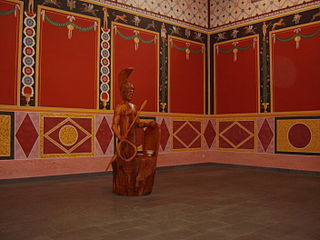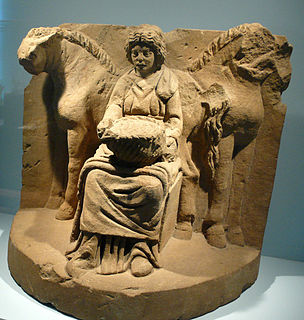
Mercury is a major god in Roman religion and mythology, being one of the 12 Dii Consentes within the ancient Roman pantheon. He is the god of financial gain, commerce, eloquence, messages, communication, travelers, boundaries, luck, trickery and thieves; he also serves as the guide of souls to the underworld.

Phobos is the personification of fear and panic in Greek mythology. Phobos was the son of Ares and Aphrodite, but does not have a distinct role in mythology outside of being his father's attendant.
Endovelicus, is the best known of the pre-Romans Lusitanian and Celtiberian gods of the Iron Age. He was originally a chthonic god of health, prophecy and the earth, associated with vegetation and the afterlife. Later accepted by the Romans themselves, who assimilated it to Asclepius or to Serapis and made him a relatively popular god.
Belatucadros or Belatucadrus, was a deity worshipped in Celtic northern Britain, particularly in Cumberland and Westmorland. In the Roman period he was identified with Mars and appears to have been worshipped by lower-ranked Roman soldiers as well as by Britons. In five inscriptions he is called Mars Belatucadrus and the name is frequently translated as "fair shining one" or "fair slayer."
Belenus is a sun god from Celtic mythology and, in the 3rd century, the patron deity of the Italian city of Aquileia. Called the "Fair Shining One", he was one of the most ancient and most-widely worshiped Celtic deities and is associated with the ancient fire festival and modern Sabbat Beltane. He was associated with the horse and also the wheel. Perhaps like Apollo, with whom he became identified in the Augustan History, Belenos was thought to ride the Sun across the sky in a horse-drawn chariot.
In Celtic mythology, Condatis was a deity worshipped primarily in northern Britain but also in Gaul. He was associated with the confluences of rivers, in particular the River Wear which runs its course largely within County Durham. Condatis is known from several inscriptions in Britain and a single inscription found at Alonnes, Sarthe, France. In each case he is equated with the Roman god Mars.

Grannus was a Celtic deity of classical antiquity. Based on the etymology of his name, Grannus may have been associated with spas, thermal springs, and the sun; having bushy hair, beard and/or eyebrows; or having a connection with the concept of shining/gleaming. He was regularly identified with Apollo as Apollo Grannus. He was frequently worshipped in conjunction with Sirona, and sometimes with Mars and other deities.
In Gallo-Roman religion, Loucetios was a Gallic god known from the Rhine-Moselle region, where he was invariably identified with the Roman Mars. Scholars have interpreted his name to mean ‘lightning’. Mars Loucetius was worshipped alongside the goddess Nemetona.

Nodens is a Celtic deity associated with healing, the sea, hunting and dogs. He was worshipped in ancient Britain, most notably in a temple complex at Lydney Park in Gloucestershire, and possibly also in Gaul. He is equated with the Roman gods Mars, Neptune and Silvanus, and his name is cognate with that of the Irish mythological figure Nuada and the Welsh Nudd.

In Gallo-Roman religion, Smertrios or Smertrius was a god of war worshipped in Gaul and Noricum. In Roman times he was equated with Mars. His name contains the same root as that of the goddess Rosmerta and may mean "The Purveyor" or "The Provider", a title rather than a true name. Smertulitanus may be a variant name for the same god.
Lusitanian mythology is the mythology of the Lusitanians, the Indo-European people of western Iberia, in the territory comprising most of modern Portugal, Galicia, Extremadura and a small part of Salamanca.
Cult is the "care" owed to deities and temples, shrines, or churches. Cult is embodied in ritual and ceremony. Its present or former presence is made concrete in temples, shrines and churches, and cult images, including cult images and votive offerings at votive sites.

A nemeton was a sacred space of ancient Celtic religion. Nemeta appear to have been primarily situated in natural areas, and, as they often utilized trees, they are often interpreted as sacred groves. However, other evidence suggests that the word implied a wider variety of ritual spaces, such as shrines and temples. Evidence for nemeta consists chiefly of inscriptions and toponymy or place-names, which occur all across the Celtic world. Toponyms related to the word nemeton occur as far west as Galicia in the Iberian peninsula, as far north as Scotland, and as far east as central Turkey. The word is related to the name of the Nemetes tribe living by the Rhine between the Palatinate and Lake Constance in what is now Germany, and their goddess Nemetona.

Lenus was a Celtic healing god worshipped mainly in eastern Gaul, where he was almost always identified with the Roman god Mars. He was an important god of the Treveri tribe, who had large sanctuaries at medicinal springs at Trier and the Martberg by Pommern in what is now Germany. Two dedications to him are also known from southwestern Britain. Edith Wightman characterizes him as “one of the best examples of a Teutates, or god of the people, equated with Mars—protector of the tribe in battle, but also [...] bestower of health and general good fortune” (p. 211). His sanctuary ‘Am Irminenwingert’ at Trier had a large temple, baths, smaller shrines and a theatre; that on the Martberg also included a large variety of buildings, probably including rooms for health-seeking pilgrims to stay. Despite his associations with healing, Lenus Mars is depicted classically as a warrior with Corinthian helmet in a bronze statuette from the Martberg.
Ocelus is a celtic god known from three inscriptions in Roman Britain. He is twice invoked on dedications at Caerwent: one stone is the base of a statue of which only a pair of human feet and a pair of goose feet survive. The invocation is to Mars Lenus or Ocelus Vellaunus and the "numen" (spirit) of the emperor, and was dedicated on 23 August AD 152. The second Caerwent inscription dedicates an altar to Mars Ocelus. The god was also venerated at Carlisle, where he was once more equated with Mars and again linked to the imperial cult. So Ocelus seems to have been a British, perhaps Silurian god, associated with Mars, probably in the latter's Celtic capacity as a protector. At Caerwent he is linked with Lenus, a Treveran healing deity, and with Vellaunus, who is recorded among the Gaulish Allobroges.

Litavis is a Gallic deity whose cult is primarily attested in east-central Gaul during the Roman period. She was probably an earth-goddess.

In ancient Roman religion and myth, Mars was the god of war and also an agricultural guardian, a combination characteristic of early Rome. He was the son of Jupiter and Juno, and he was the most prominent of the military gods in the religion of the Roman army. Most of his festivals were held in March, the month named for him, and in October, which began the season for military campaigning and ended the season for farming.

The gods and goddesses of the pre-Christian Celtic peoples are known from a variety of sources, including ancient places of worship, statues, engravings, cult objects and place or personal names. The ancient Celts appear to have had a pantheon of deities comparable to others in Indo-European religion, each linked to aspects of life and the natural world. By a process of syncretism, after the Roman conquest of Celtic areas, these became associated with their Roman equivalents, and their worship continued until Christianization. Pre-Roman Celtic art produced few images of deities, and these are hard to identify, lacking inscriptions, but in the post-conquest period many more images were made, some with inscriptions naming the deity. Most of the specific information we have therefore comes from Latin writers and the archaeology of the post-conquest period. More tentatively, links can be made between ancient Celtic deities and figures in early medieval Irish and Welsh literature, although all these works were produced well after Christianization.
The religious element is difficult to identify in Mycenaean Greece, especially as regards archaeological sites, where it remains very problematic to pick out a place of worship with certainty. John Chadwick points out that at least six centuries lie between the earliest presence of Proto-Greek speakers in Hellas and the earliest inscriptions in the Mycenaean script known as Linear B, during which concepts and practices will have fused with indigenous Pre-Greek beliefs, and—if cultural influences in material culture reflect influences in religious beliefs—with Minoan religion. As for these texts, the few lists of offerings that give names of gods as recipients of goods reveal nothing about religious practices, and there is no surviving literature. John Chadwick rejected a confusion of Minoan and Mycenaean religion derived from archaeological correlations and cautioned against "the attempt to uncover the prehistory of classical Greek religion by conjecturing its origins and guessing the meaning of its myths" above all through treacherous etymologies. Moses I. Finley detected very few authentic Mycenaean reflections in the eighth-century Homeric world, in spite of its "Mycenaean" setting. However, Nilsson asserts, based not on uncertain etymologies but on religious elements and on the representations and general function of the gods, that many Minoan gods and religious conceptions were fused in the Mycenaean religion. From the existing evidence, it appears that the Mycenaean religion was the mother of the Greek religion. The Mycenaean pantheon already included many divinities that can be found in classical Greece.
The Dexivates were a small Gallic tribe dwelling in the southern part of modern Vaucluse, near the present-day village of Cadenet, during the Iron Age and the Roman period.












